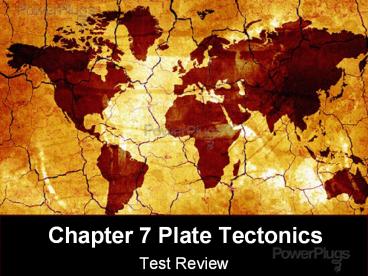Chapter 7 Plate Tectonics - PowerPoint PPT Presentation
1 / 20
Title:
Chapter 7 Plate Tectonics
Description:
Chapter 7 Plate Tectonics ... Arial Calibri Block Tilt BRK Demo WorldMap print PowerPlugs Templates for PowerPoint 1_Demo WorldMap print PowerPlugs Templates ... – PowerPoint PPT presentation
Number of Views:247
Avg rating:3.0/5.0
Title: Chapter 7 Plate Tectonics
1
Chapter 7 Plate Tectonics
- Test Review
2
Plate Tectonics
- 1. When rock changes its shape due to stress,
this reaction is called ____________________. - deformation
- 2. The stress that occurs when two tectonic
plates collide is called ____________________. - compression
3
Plate Tectonics
- 3. _________________________ is the theory that
the Earth's lithosphere is divided into tectonic
plates that move around on top of the
asthenosphere. - Plate tectonics
- 4. The region where oceanic plates sink down into
the asthenosphere is called a ___________. - subduction zone
4
Plate Tectonics
- 5.When Earth's magnetic poles change place, this
is called a(n) ____________________ reversal. - magnetic
- 6. _________________________ are underwater
mountain chains that run through Earth's ocean
basins. - Mid-ocean ridges
5
Plate Tectonics
- 7. _________________________ is the process by
which new oceanic lithosphere is created as older
materials are pulled away. - Sea-floor spreading
- 8. The center of the Earth is called the
____________________. - core
6
Plate Tectonics
- 9. Anticlines and synclines are the result of
____________________. - folding
- 10. The ridge in the middle of the Atlantic Ocean
formed along a ____________________ boundary. - divergent
7
Plate Tectonics
- 11. Earth's ____________________ is liquid.
- outer core
- 12. _____ type of mountain is the only one that
is formed by adding new material to the Earth's
surface. - volcanic
8
Plate Tectonics
- 13. Mountains with sharp, jagged peaks, such as
the Tetons, in western Wyoming, that are produced
when sedimentary rock layers are tilted up by
faulting are called ____ mountains. - fault-block
- 14. The Mariana trench is the deepest point in
the oceans11,033 m below sea level. This trench
was formed at a ____ boundary, where one tectonic
plate was subducted beneath the other. - convergent
9
Plate Tectonics
- 15. A ____ fault often results when opposing
forces cause rock to break and move horizontally. - strike-slip
- 16. The type of fault that often results when
rocks are pulled apart due to tension is called a
_____. - normal fault
10
Plate Tectonics
- 17. When horizontal stress acts on a rock, ____
and ___form. - synclines and anticlines
- 18. When two tectonic plates slide past each
other horizontally, the boundary between them is
called a _____. - transform boundary
11
Plate Tectonics
- 19. ____ is the process by which hot material
from deep within the Earth rises while cooler
material near the surface sinks. - Convection
- 20. Wegener's continental drift theory suggests
that at 245 million years a single landmass was
surrounded by a sea called _____. - Panthalassa
12
Plate Tectonics
- 21. The North American plate consists _____.
- of both continental and oceanic crust
- 22. The thinnest part of a tectonic plate lies
beneath _____. - the middle of the ocean
- 23. There are_____ major tectonic plates.
- ten
13
Plate Tectonics
- 24. The ____ is divided into tectonic plates.
- lithosphere
- 25. The ____ is made of solid rock that flows
very slowly. - asthenosphere
- 26. The word asthenosphere means _____.
- "weak sphere"
14
Plate Tectonics
- 27. The word lithosphere means
- "rock sphere"
- 28. The soft layer of the mantle on which pieces
of the lithosphere move is called the _____. - asthenosphere
- 29. The strong, lower part of the mantle that
lies beneath the asthenosphere is called the
_____. - mesosphere
15
Plate Tectonics
- 33. The outermost, rigid layer of the Earth is
called the _____. - lithosphere
- 34. The diameter of the Earth's core is slightly
larger than the diameter of _____. - Mars
- 35. Scientists have learned that the mantle's
composition has large amounts of _____. - iron and magnesium
16
Plate Tectonics
- 36. Earth's lightest materials make up the _____.
- crust
- 37. _____ appears to cause movement of Earth's
tectonic plates. - convection currents below the lithosphere
- 38. The speed of seismic waves depends on the
____ of the layer through which they travel. - density
17
Plate Tectonics
- 39. _____makes up most of the Earth's mass.
- Mantle
- 40. The type of mountain involving huge sections
of the Earth's crust being pushed up into
anticlines and synclines is the _____. - folded mountain
18
Plate Tectonics
- 41. The San Andreas fault is an example of a
_____. - transform boundary
- 42. The part of the Earth on which the tectonic
plates are able to move is the _____. - asthenosphere
19
Plate Tectonics
- 43. The part of the Earth that is a liquid is the
_____. - outer core
- 44. The asthenosphere is the thinnest layer.
- False
- 45.Temperature and pressure increase toward the
center of the Earth. - True
20
Plate Tectonics
- The inner core of the Earth is solid and made
primarily of iron. - True
- The crust is the Earth's only solid layer.
- False































